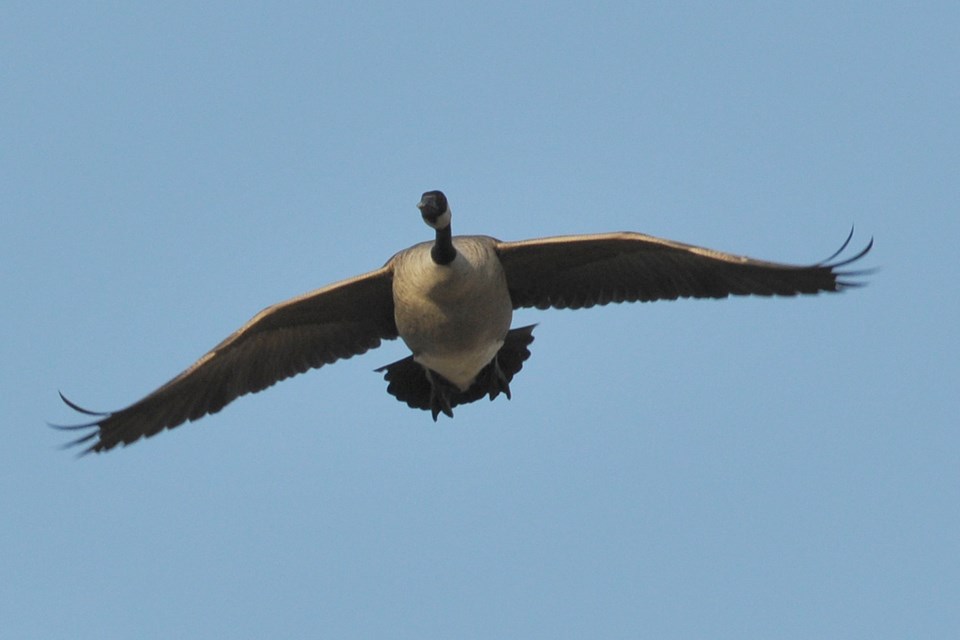Is there anything more iconic for the season than to see and hear a flock of Canada geese flying by overhead? Sometimes you first hear them and will stop whatever it is you are doing and look skyward, wondering if they will be low enough and close enough to be seen through the branches of the colourful maple tree.
And there they are! The flock arranged in their perfect V formation. Calling. Flying. Heading south. A few moments later and they are gone, disappearing over the distant horizon. You go back to whatever it was you were doing, somehow feeling connected to this eons-old experience.
Wait. What? Eons old? (This is where I scratch the needle across that musical soundtrack that was playing in your head.) Not so!
Before I get into that, let’s first discuss the naming of said birds. Were they Canadian geese? Probably, as they were flying southward from here. But despite being Canadian born (or rather hatched), were they Canada geese or snow geese? See my grammatical point?
So, now that we have established they were Canadian Canada geese, let’s delve into the history of these birds. (Oh, one more thing: If a Canada goose is hatched in the U.S. of A., it’s still a Canada goose, albeit an American one.)
Here in southern Ontario there have been observations of Canada geese noted for many years, going back to the 1600s. Within the writings of the Jesuit Relations, there is mention that in 1624, “… likewise bustards or wild geese, which they call ‘Ahonque,’ for there are plenty of them in the country.” Say what? “A honk?” Methinks a Jesuit scribe hast been the brunt of an Indigenous punster.
Again, in June of 1637, the occurrence of a goose encounter is noteworthy enough to be included in these historical documents, as “four bustards were killed.”
Within O.E. Devitt’s 1967 book, The Birds of Simcoe County, he further recounts Canada geese were seen in late March of 1815 at Kempenfelt Bay (Lake Simcoe), and that flocks of these birds were noted flying over Holland Marsh in October of 1890.
What is interesting (to me, at least) is the Canada geese being referred to here are not the same variety of Canada geese we see today. Those geese of yore were most likely birds that had nested in the Hudson Bay Lowlands and were on migration through this area.
So, now we delve into “varieties” of Canada goose, of which there are many. Prior to 1970 the local field guides would mention Richardson’s Canada goose and cackling Canada goose (both quite small, not much bigger in body than a good-sized black duck) and just plain Canada goose. Out west, in Saskatchewan and Alberta, there were a couple of other varieties, including dusky Canada goose and giant Canada goose.
And so to be a birdwatcher of repute, you had to know your goose ident beyond it being black and white and saying “a honk.”
However, in the late 1960s the Ontario government thought it a grand idea to import some of those giant Canada geese from Saskatchewan into Ontario. More bang for your buck from a goose hunter’s perspective.
In 1968 a few breeding pairs were captured and brought to introduction sites, those being Tiny Marsh (near Elmvale) and Wye Marsh (near Midland). Special ponds were dug, chain-link predator-proof fences installed, and a conservation officer assigned to watch over these feathered immigrants. Throughout the winter, ice was broken from the surface of the ponds for the birds to enjoy, and bags of corn and other grains hauled in daily to ensure healthy breeding geese in springtime.
The birds did what they were supposed to do in March, and by late summer a gang of goslings were released to the wild. Would this introduction work? Would any survive?
Methinks you know the answer to that one.
The giant Canada goose is now the most common and prolific of any variety of this species to glide across Ontario. So, while, yes, the colonists and Indigenous folks of old did indeed see geese migrating through each spring and fall, never had they seen what we see today — the autumn sky filled with thousands of geese.
Of course, while on the subject of local geese, there are those who will ask if perhaps this introduction was maybe, you know, too much of a good thing. Unless you are a golfer or beach goer, then, hey, stop a moment and look skyward to regale in what is a recent ‘natural’ phenomenon, the annual migration of the Canadian geese. (Of which many will indeed be Canada geese.)



